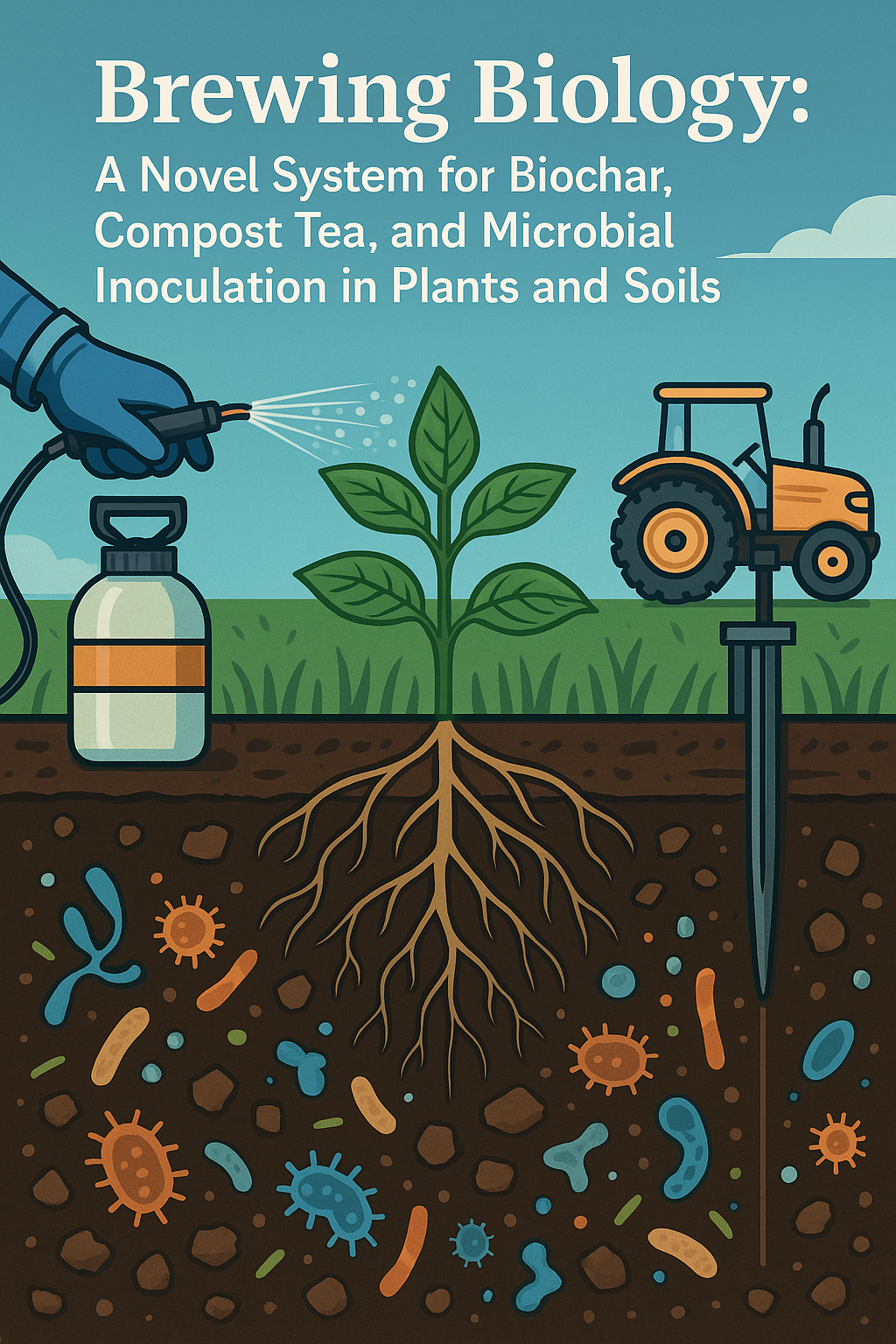By David Bennett
What if we could help plants not just from the ground up, but also from the top down? That question led to the development of a novel concept in sustainable biology: a hybrid system that applies compost tea and biochar both as a foliar spray and as a subsoil slurry injection. The goal? To colonize entire plants with beneficial microbes, boost nutrient cycling, increase disease resistance, increase water retention in soils, and create a pathway for carbon credit generation through carbon sequestration.
The Foliar Spray System: Glomalin as Glue and Biochar as a Vehicle
Traditionally, arbuscular mycorrhizal fungi (AMF) are known for root-zone symbiosis. They help plants access nutrients like phosphorus, secrete glomalin (a glue-like glycoprotein), and improve drought tolerance. This article proposes an aerial twist: using AMF-rich compost tea mixed with fine-particle biochar as a foliar spray. The glomalin could help endophytic innoculated biochar particles adhere to leaf surfaces, increasing the likelihood of microbial colonization of treated plant structures like leaves.
While AMF typically colonize roots, some fungal and bacterial endophytes naturally inhabit leaf, stem, and even floral tissues. Trichoderma spp. and Beauveria bassiana, for instance, are fungal endophytes known to colonize above-ground parts, offering pathogen resistance and pest deterrence. On the bacterial side, species like Bacillus subtilis, Pseudomonas fluorescens, and Azospirillum brasilense support nutrient uptake and plant immune responses. By brewing a fungal-dominant tea first, and then adding these bacterial endophytes later, this approach ensures optimal growth conditions for each group.
Synergy in the Microbial Mix
Trichoderma thrives in aerated brews. Beauveria bassiana may be added late in the process to prevent oxygen stress. While Epichloë species are harder to propagate outside host seeds, the use of other resilient endophytes more than compensates. Bacterial players such as Bacillus subtilis and Pseudomonas fluorescens also integrate well when added after the fungal population is established.
Automation plays a key role here. With temperature, pH, and oxygenation controlled via digital sensors and timed dosing pumps, the foliar system could be precisely calibrated for microbial compatibility and stability.
Each group occupies its niche—biofilms, leaf interiors, root hairs, or biochar pores—without aggressive competition, creating a layered inoculation strategy for full-spectrum plant and soil health.
The Keyline Plow System: Injecting Life Into the Soil
For deeper soil integration, the system incorporates a keyline plow with a modified slurry injection apparatus. Originally designed to improve water infiltration and root depth, the keyline plow forms ideal channels 30–45 cm deep. When combined with slurry injection, these furrows become delivery routes for microbial-rich compost tea and biochar.
The unique geometry of the keyline shanks—resembling an inverted boat hull—creates lateral fractures in the soil. This could help spread the slurry horizontally as well as vertically, encouraging microbial colonization beyond the injection point. This functions somewhat like an inverted version of hydraulic fracturing (“fracking”) used in petroleum extraction—though in a regenerative and environmentally beneficial context. The biochar serves as a microbial habitat, gradually releasing the inoculant and improving long-term soil structure and fertility.
The VOGT Injector System: Point-Based Subsoil Delivery
In addition to the keyline method, the VOGT Geo Injector Pro system offers a precise, point-injection solution. Designed for golf courses, tree care, and compacted soil environments, this device aerates the soil while injecting microbial solutions and amendments at controlled depths—typically 30 to 50 cm. It operates through repeated static injections at set intervals (50 cm to 1 m apart), making it especially useful in areas where continuous furrow injection isn't practical. While slower than a keyline approach, it allows for pinpoint delivery of compost tea and biochar slurry in tight, high-traffic, or ecologically sensitive zones.
Client Base and Market Potential
This system isn't just for farmers. Its potential clients include:
- Ranches seeking pasture resilience and improved forage
- Golf courses needing turf that withstands traffic and reduces chemical use
- Residential clients looking for eco-conscious lawn care
- Organic farms interested in replacing synthetic inputs with biologicals
For residential applications, foliar and topsoil applications can be applied in as little as 1–2 hours, offering a scalable service. For larger operations, the slurry injection via keyline plow can cover thousands of acres in a season. For specialty landscapes or targeted remediation, the VOGT injector system provides a slower but more targeted delivery method
Carbon Credits: A Revenue Pathway
Biochar is not just a soil amendment—it’s a form of carbon sequestration. Each ton of biochar can sequester roughly 1 to 1.2 tons of CO2 equivalent. With carbon credits currently trading between $42–$60 per ton in the U.S. and Europe, landowners and service providers can monetize their practices.
A 1,000-acre project applying 1 lb of biochar per linear foot (using a 3-shank plow at 2-foot spacing) could sequester between 5,800 and 7,200 tons of CO2—potentially generating over $250,000 in carbon credit revenue alone. Smaller residential applications sequester proportionally less, but still offer a green value-add.
Conclusion
This biologically integrated dual-delivery system represents a scalable, science-backed innovation in sustainable agriculture and land care. With potential benefits across nutrient cycling, pest resistance, soil health, and revenue generation through carbon credits, it bridges ecological stewardship with economic viability.
While still theoretical, the principles behind it are rooted in well-established microbiology, mycology, and soil science. Further research and trials could validate its use, paving the way for a new era in regenerative land management.
For the curious grower, landscaper, or eco-entrepreneur, this system represents not just a method—but a movement toward living soil and living profit.

